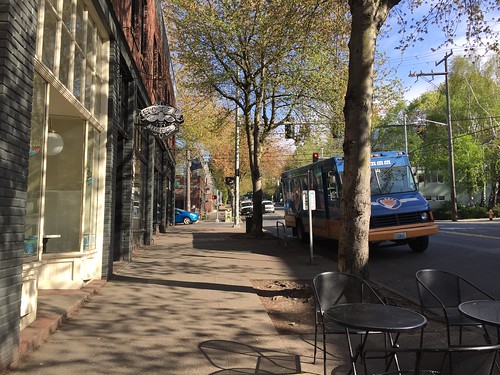The pink set sun bounced off the Adriatic, illuminating the golden crust. You’d have heard the shatter of knife piercing through if not for the whistling breeze and breaking waves. We sat meters away at a table nestled in the sand. During my week living with a host family in San Bendetto del Tronto, a seaside resort in Italy’s central Le Marche, I’d grown used to this panorama. I’d also grown used to the food. Forget the platters of squishy spaghetti ai frutti di mare tourists ate at nearby seaside restaurants. My host family and I chowed down on pre-fried, oven-reheated spinacine — spinach and chicken patties — fresh from the plastic freezer packaging.
Some fall for Italian food when served dishes toothy pasta flecked with guanciale or salads glowing with olive oil slick tomatoes. Not I. I reveled in meals that would challenge seasoned food photographers. I discovered Italian cuisine as imagined by Esselunga, Coop and Conad — the country’s main supermarket chains. Meandering through their aisles with my host family and, later, on my own, the diverse palette revolutionized my understanding of food’s affective potential. From mossy green spinacine and wheat-yellow Mulino Bianco biscuits to deep-orange peach Esta Thé and vivid blue Barilla boxes, the exotic personalities of Italy’s industrial food products beguiled me. Although popular American culture lauds an Italian cooking that features local produce, hyper-regional recipes and smiling grandmothers, the reality I encountered demonstrated a different fantasy of Belpaese gastronomy.
That’s not to say this traditional cuisine doesn’t exist but rather that it doesn’t speak to the range of diets present that characterize the Peninsula in the 21st century. Since the 1950s, with the influx of foreign aid from the Marshall Plan, Italians have increasingly eschewed rural life in favor of urban existence as dictated by industry. Daily routines have responded to these changes in institutional structures. ISTAT, Italy’s equivalent of the Census Bureau, shows that the intervening 60 years has led Italians to eat breakfast regularly and to consume lunch at work or school, while dinner remains a daily family ritual, though with less time devoted to preparing it. These years also witnessed an influx of new products from frozen and prepared foodstuffs to international restaurant chains and exotic cuisines. As incomes ballooned, Italian families spent money on the luxury foods previously restricted to fantasies and Christmas. Although Italian cooking based on whole ingredients — the kind lauded travelogues — remains relevant to Italy’s 21st-century consumers, overlooking the country’s burgeoning industrial food sector betrays the complexity of the Belpaese’s culinary history.
I first encountered Italian industrial food at breakfast, coating perfect-crescent shaped brioche with abundant spoonfulls of Nutella. Breakfast highlights the interplay between whole foods and industrial production in creating the contemporary Italian diet. From the plastic wrapped fette biscottate to the apricot crostata with an eerily perfect lattice crust, Italy’s industrial bakeries provide Italians with nostalgia during the hours when it would be most difficult to prepare. In recounting their prima colazione of years past, older Italians mention meals of dried bread dipped in tazze d’orzo or the occasional piece of fresh bread with a veil of jam. Although these breakfasts might seem easy to reproduce within a chaotic modern schedule, the country’s increasingly sedentary lifestyle combined with an emphasis on dieting means that breakfast no longer needs to provide fuel, but a delicious antidote to the work day’s oncoming stress. Whether pausing for a caffè and fluffy brioche at the bar or dunking crumbly biscuits in caffelatte at the kitchen table, the contemporary Italian breakfast is a quick routine that demonstrates the triumph of urban consumption over utilitarian fuel.
But nostalgia remains for the old ways. Mulino Bianco — a subsidy of Barilla pasta — responds by producing biscuits, snacks, American-style loaf bread and cakes for grocery stores that pair the desire for the past with modernity’s convenience. Barilla introduced the brand in 1974 to consolidate their presence in the burgeoning consumer food market. Since then, the company’s astute marketing has propelled them to dominate Italy’s baked good sector with a 6.9% share of the market in 2014. From a life-sized recreation of their namesake ‘white mill’ to an array of games and prizes to entice kids, Mulino Bianco constructs a universe in which the rural dream of cucina povera — literally ‘poor cooking’ — manifests itself in mass culture.
Following Mulino Bianco’s success, other companies have capitalized upon the Italian desire for bygone foodways through ready meals, food chains and novelty products. These brands suggest that only modern consumption patterns can recapture Italy’s fabled quality comestibles. Grom, an international gourmet gelato chain founded in Turin, describes themselves as ‘il gelato come una volta’ — ice cream as it used to be. If a proliferation of options defines contemporary consumer society, then Grom emphasizes the singularity of their gelato to feign opposition to the market system that enables their existence. But a quick stroll through the grocery stroll reveals Grom doesn’t monopolize bygone quality. There’s Motta’s Antica Gelateria del Corso (roughly translated as ye olde gelato shop on main street), which sells a supermarket frozen desserts. There’s Viva la Mamma box, which offers microwaveable packages of pasta in traditional sauces like a mythical mamma might make. Although the industrial correlation of quality, nostalgia and industry might baffle the foreigner habituated to the idyllic notion of agriturismo, both representations share a belief that modern-life has resituated the role quality and pleasure play in the domestic Italian kitchen.
Even agriturismo dreams are ceding to industrial bounty. Eataly, the international chain of Italian grocery stores aligned with Slow Food (most vocally so in Italy), offers pre-packaged soups, mass produced biscuits and cases of bottled mineral water. In this sense, the regular presence of industrial food in the Italian diet suggests a stronger influence than the occasional agriturismo. This isn’t to say that Italians only eat processed foods or don’t champion traditional products — they have the highest amount of DOP and IGP protected products in the EU. Rather, it suggests the contemporary Italian dietary landscape is more complex and joyfully paradoxical than the foreign tourism imaginary illustrates.
During my years living in Italy I have spent hours in supermarkets analyzing novel pasta shapes, erudite frozen foods and delightful merendine, snack cakes. Each new product presents a new marvel. From the salty crunch of a spinacine — spinach and chicken croquette — to the rough crunch of a Mulino Bianco biscuit — tarallucci, please! — Italian industrial food products speak to my imaginary of Italian food in a way that reality fails to do. Reality is saddled with history. Italian gastronomy’s complex vocabulary and philology marks every menu, both at home and abroad. The burden of ordering becomes the burden of history — don’t get the gnocchi al tartufo in Naples or gnocchi alla romana in Turin. Although internal migration has mitigated the distinctions between regions, each area retains authority over the recipes from their environs. A different history applies to Italian industrial foodstuffs — the history of fantasy. Ripping open the plastic on a Pan di Stelle cake or cracking open a box of trofie al pesto from Viva la Mamma allows you to feign the tradition you want. Close your eyes and you can ramble around Puglia’s gravelly hills or spill sauce on mamma’s yellow tablecloth. Close your eyes and relish your Italian food dream.










